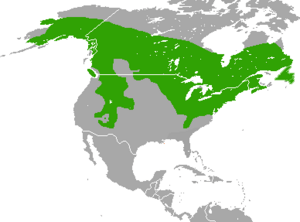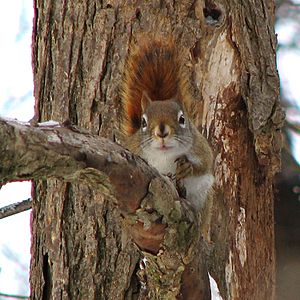American red squirrel facts for kids
Quick facts for kids American red squirrel |
|
|---|---|
 |
|
| at Cap Tourmente National Wildlife Area, Quebec | |
| Conservation status | |
| Scientific classification | |
| Genus: |
Tamiasciurus
|
| Species: |
hudsonicus
|
| Subspecies | |
|
|
 |
|
| Distribution | |
The American red squirrel (Tamiasciurus hudsonicus) is a small, active tree squirrel. It is also known as the pine squirrel or chickaree. You might hear it called the North American red squirrel too. This squirrel is about 200 to 250 grams (7 to 9 ounces) in weight. It is a diurnal animal, meaning it is active during the day.
American red squirrels are known for defending their own space all year long. They mostly eat seeds from conifer trees, like pinecones. You can find them across North America where these trees grow. However, they are not common on the Pacific coast. There, their relative, the Douglas squirrel, lives instead. They are also not found in most of the Great Plains or the southeastern United States. This is because conifer trees are not common in those areas. Recently, these squirrels have started moving into forests with hardwood trees.
Contents
What Makes Red Squirrels Special?
Red squirrels are easy to spot among other North American tree squirrels. They are smaller, measuring about 28 to 35 centimeters (11 to 14 inches) long, including their tail. They have reddish fur and a white belly. Red squirrels are a bit bigger than chipmunks. The Douglas squirrel looks similar but has a rust-colored belly. Douglas squirrels live only in the southwestern coast of British Columbia and the Pacific Northwest of the United States. The areas where these two squirrel types live do not overlap.
Where Do American Red Squirrels Live?

American red squirrels live in many parts of North America. Their home range includes most of Canada, except for the far northern areas without trees. They also live in the southern half of Alaska. In the United States, they are found in the Rocky Mountains and the northern half of the eastern states.
These squirrels are very common in most of their range. They are not considered a species of concern. Even though the map might not show it, red squirrels were brought to the island of Newfoundland and now live there in large numbers. However, a small group of red squirrels in Arizona has seen their numbers drop a lot. Because of this, they were listed as an endangered species in 1987.
How Red Squirrels Live
What Do Red Squirrels Eat?

American red squirrels mainly eat seeds. But they also eat other foods when they can find them. In Yukon, scientists watched red squirrels closely. They found that white spruce seeds make up more than half of a squirrel's diet. Squirrels also eat spruce buds and needles, mushrooms, and willow leaves. They might also eat poplar buds, bearberry flowers and berries. Sometimes, they even eat bird eggs or young snowshoe hares.
White spruce cones are ready in late July. Red squirrels collect these cones in August and September. They store the harvested cones in a central hiding spot. This stored food helps them survive the winter and have babies in the spring. The leftover scales from eaten cones can form large piles called middens. These middens can be up to twelve meters (40 feet) across! White spruce trees produce a lot of cones every two to six years. This is called a "mast year." After a mast year, there are several years with fewer cones. A red squirrel's territory might have one or many middens.
Red squirrels eat many kinds of mushrooms. Some of these mushrooms are even deadly to humans!
How Red Squirrels Have Babies
Male squirrels compete to mate with females. A female squirrel might mate with 4 to 16 different males. Pregnancy lasts about 31 to 35 days. Females can have their first babies when they are one year old. But some females wait until they are two years old or older. Most females have one litter of babies each year. Sometimes, they skip a year of breeding. Other times, some females have two litters in one year. A litter usually has one to five babies. Most litters have three or four babies.
Baby squirrels are born pink and without fur. They weigh about 10 grams (0.35 ounces). They grow about 1.8 grams (0.06 ounces) each day while they are nursing. They reach adult size at about 125 days old. They first come out of their nest around 42 days old. But they keep nursing until they are about 70 days old.
Squirrel nests are often made of grass in tree branches. They also build nests in "witches' broom." This is a thick growth of branches caused by a plant disease. Nests can also be in holes in spruce, poplar, and walnut trees. American red squirrels rarely nest underground. Each squirrel has several nests in its territory. Mothers with young babies move them between these nests. Sometimes, squirrels even build nests inside human homes using insulation!
Moving and Surviving
Young American red squirrels need to find their own territory and a midden before their first winter. This is important for them to survive. They can get a territory by competing for an empty one. They can also create a new territory. Sometimes, their mothers give them all or part of their own territory. This is a special way mothers help their young. It happens more often when there is plenty of food. Young squirrels who don't get a territory from their mother usually settle close to where they were born.
Many young American red squirrels do not survive their first year. On average, only 22% live to be one year old. But if they make it to one year, their chances of survival get better until age three. After age three, their survival chances start to go down. Females who live to one year old can expect to live for about 2.3 more years. The oldest recorded red squirrel lived for eight years.
Many animals hunt American red squirrels. These include the Canada lynx, bobcat, coyote, great horned owl, northern goshawk, red-tailed hawk, American crow, American marten, red fox, gray fox, wolf, and weasel.
Images for kids
See also
 In Spanish: Ardilla roja americana para niños
In Spanish: Ardilla roja americana para niños




